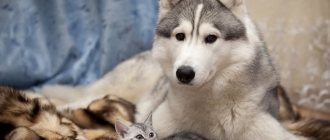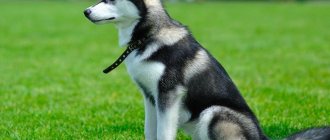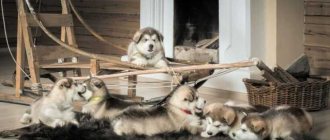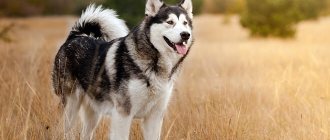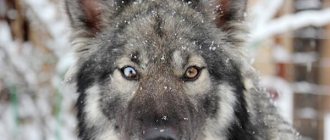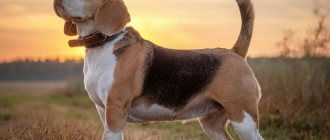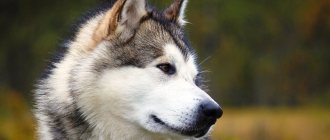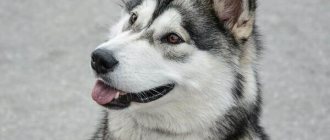The Alaskan Malamute can be called a domestic wolf, for its amazing resemblance to its wild relative, as well as strength, endurance and strong character. However, despite their large size, these creatures are extremely kind and friendly even to strangers. Such a pet will definitely become a full member of the family, a companion and playmate. Owners and breeders highlight the following distinctive features of the breed:
- A strong character, which sometimes borders on stubbornness, and the habits of a gentleman. Adults are regal, proud, cultured and reserved;
- Need for work. The dog requires significant physical activity and long walks;
- An urgent need for constant communication. Lack of attention leads to obstinacy, gloominess, and sometimes aggressiveness;
- Intelligence, well-developed intuition and ability to make independent decisions;
- Growling instead of barking. Malamutes are extremely talkative and express their emotions with sounds that resemble grunts;
- Thick fur and the need for careful care.
Short description
These are powerful dogs with a strong and muscular body. Adult males reach 63.5 cm at the withers and weigh 38 kg, females grow up to 58.5 cm and weigh 35 kg.
For dogs that meet the breed standard:
- wide but proportional head;
- voluminous muzzle;
- erect, wide-set, V-shaped ears with rounded tips;
- scissor bite;
- small almond-shaped eyes, brown iris;
- the nose is colored black or brown;
- powerful limbs with developed muscles.
Alaskan Malamutes have a two-layer coat, consisting of a dense fluffy undercoat about 2.5-5 cm long and thick and coarse guard hairs maximum 7.5-10 cm long..
Long-haired dogs whose coat length exceeds these indicators are considered plembrac.
Origin story
Alaskan Malamutes are a breed of dog originally from Alaska, descended from domesticated dogs of the Malamute tribe, which were characterized by strength, power and a high degree of endurance.
The Malemuts used these animals for riding and transporting goods.
The peak of development and spread of the breed occurred at the end of the 19th century, during the so-called “gold rush” . This happened because gold miners could only reach the deposits by sledding Alaskan Malamutes.
In order to increase the number and increase the endurance of dogs, they were crossed with representatives of other breeds, which is why the number of purebred individuals significantly decreased.
The revival of the breed began only after sled racing gained popularity, and the risk of extinction of Alaskan Malamutes was completely avoided only in the 20s. XX century
The breed received official recognition in 1935.
Character traits
Alaskan Malamutes, due to their large size, may appear to be intimidating dogs, but in fact they are very sociable and good-natured.
These dogs cannot be guards because they are not aggressive at all and are friendly towards everyone without exception..
Being pack animals, Malamutes need constant communication with people and other animals; living in isolation negatively affects their health.
They also need regular active walks, physical activity and a variety of activities, since the monotonous repetition of the same actions quickly causes them boredom.
Despite the attachment to the owner, it is important for Malamutes to constantly confirm his leadership and authority - as soon as a person shows weakness, the pet begins to look for a leader in someone else.
It is also important to remember that representatives of this breed are stubborn, willful and prone to dominant behavior, so it can be difficult to train them.
If you don’t have confidence in your own abilities, it is better to turn to professional dog handlers and undergo OKD.
Expert opinion
Kozhevin Semyon Kirillovich
Expert dog handler.
Representatives of this breed are definitely not suitable as a first pet for novice dog owners. Only an experienced person with leadership qualities and a strong character can cope with the stubbornness, willfulness and desire to dominate the Alaskan Malamute. Malamutes are not aggressive by nature, but this behavior can be provoked by psychological trauma suffered at an early age, errors in upbringing, cruel treatment and some other reasons.
Breeding recommendations
Puberty in Malamutes occurs up to 6 months. Important subtleties that you should know about when breeding a dog for the first time are given below.
Estrus
A week before the start of the heat, the behavior of the Malamute girl changes. There is frequent urination.
The first heat can be divided into 2 stages:
- Up to 10 days - the appearance of mucous-bloody discharge. She doesn't let the male dog near.
- After 10 days , the discharge is clear, without blood. The perfect moment to breed a dog.
Mating
ATTENTION! Malamutes cannot be bred during their first heat, as the puppies will be weak.
It is advisable to take a male for mating from the same breeder as the female. The main thing is that the animals are healthy.
The ideal time for mating is in the morning and on an empty stomach. There are 2 options:
- Freestyle - for dogs that have already had offspring. The Malamutes are being brought together and waiting for the results.
- Manual - 2 hours animals get to know each other. Then a muzzle is put on the bitch. The male is placed next to the female and his paws are placed on her back. The procedure takes 15–45 minutes. This mating is repeated after 1–2 days.
Pregnancy
The first month of pregnancy in a Malamute passes without any changes. The dog is given the same loads, as it is full of strength and does not feel discomfort. In the 2nd month, walking time is reduced. The diet is being revised. Eating becomes easier.
2 weeks before giving birth, you will need to prepare a warm place for the pregnant woman. Place a bed and an aviary.
Childbirth
You can determine the moment of the onset of labor by the behavior of the animal. 10 hours before giving birth, the “girl” begins to worry and begins to struggle. At this moment, she needs to be taken to a pre-prepared place where she will initially live with the babies.
Stay with her. Reassure the expectant mother by talking while stroking her.
When the puppies start walking, it is better not to touch her, as she may bite. After giving birth, it is also better not to touch her and the children. After a while, call the dog to you and wipe its genitals with warm water using a sponge.
Ask someone from your family to take a walk with the young “mother.” At this time, examine the kids yourself and select outcasts. They usually don't survive.
ATTENTION! To make a Malamute accept puppies back from your hands, lubricate their faces with cow butter.
A female can only fully feed 4–5 puppies.
Castration and sterilization
The optimal age for castration is 8–10 months. Premature castration can disrupt the functions of the genitourinary system.
There are 2 ways:
- Chemical: after taking certain medications, the animal does not produce the necessary hormones. Complete sterility occurs after a month.
- Surgical - removal of the testes or ovaries is done through an incision in the abdomen or scrotum. It is performed under general anesthesia. The operation can be performed with a special instrument through a small puncture (laparoscopy).
Malamutes are huge dogs with a cheerful disposition and love of communication. At the genetic level, they have a developed pack feeling. It is very important that they accept their owner as a leader.
These shaggy giants should be trained from day one, as these dogs are not used to changing their ways. When caring, special attention is paid to the wool. Such a dog is easy to train, but at the same time, if it gets bored with training, it will not obey.
Advantages and disadvantages
Speaking about the advantages of representatives of this breed, it should be noted that they not only have an attractive appearance , but also :
- good-natured;
- friendly;
- hardy;
- smart;
- love children;
- not aggressive at all;
- sociable.
In addition, their coat does not have the unpleasant specific smell of a dog.
But Alaskan Malamutes also have disadvantages.
Yes, these dogs:
- prone to dominant behavior;
- stubborn;
- do not have protective instincts;
- independent;
- love to dig holes;
- howl often.
It should also be remembered that Malamutes should not be kept in city apartments and their communication with people or other dogs should be limited..
Puppies
You should think carefully before buying such a puppy - it requires a lot of attention, and thanks to its excessive liveliness, you will have to take long walks with your pet with active games and jogging. In addition, this dog cannot be kept in an apartment if there are people with allergies in the house. If the future owner does not have such an opportunity, it is better to abandon the idea that a Malamute will live in the house.
Choosing a puppy
Before purchasing a small pet, you need to carefully observe all the puppies from the litter - healthy dogs are extremely active, love to play, and do not show aggression. They should not have any discharge from their eyes or nose, and their fur should be fairly shiny and not dull.
It is advisable that the breeder provides all the necessary certificates and pedigree, but in this case the puppy will be expensive, but the buyer will have a guarantee that he is purchasing a healthy vaccinated puppy from elite parents.
Price
A puppy without a pedigree costs about 11,500 rubles, with a pedigree - from 12 to 29 thousand, and elite puppies from champion parents - above 30,000 rubles.
Types and their description
Malamutes are divided into 2 intrabreed species: M'Lut and Kotzebue..
Dogs belonging to the M'Lut line reach a height of 63 cm at the withers and weigh 38 kg. Their coat color is very diverse: these dogs can be black and white, gray and white, silver and white, red and white and sable.
Such Malamutes have powerful bones and large dimensions, but at the same time they are quite mobile and even graceful.
CAREFULLY!
Alaskan Malamutes of the M'Lut line have a tendency towards aggressive behavior.
Malamutes of the Kotzebue species are smaller dogs, growing to a maximum of 60 cm at the withers and weighing about 36 kg. Their coat can only be gray in color, and their character is softer and docile, with no tendency to aggression.
There are also other breeding lines of Malamutes, for example, Chinese. Each of them has its own characteristics.
Alaskan Malamute video
a brief description of
| Aggressiveness |
| Upbringing |
| Training |
| Intelligence |
| Shedding |
| Behavior with children |
| Watchman |
| Security guard |
| Difficult to care for |
| Endurance in the cold |
| Endurance in the heat |
The Alaskan Malamute cannot be called anything other than a heavy-duty dog. Designed for harness work, it was the only means of transporting goods in the snowy and cold north. The Malamute, whose photo depicts a dog in its usual conditions, looks harmonious in snowy areas and frosty air. His entire appearance echoes the local flavor, emphasizing the dog’s endurance. The eyes of a malamute can carry you away to the endless expanses of the north; they reflect loneliness and tranquility.
Interesting! Malamutes can withstand up to -70 degrees and love to sleep in snowdrifts, even if kept in a country house in an enclosure with a kennel.
Despite its large build, the Alaskan Malamute is unusually active and agile. In urban conditions, the breed lost its original functional characteristics, and Malamutes became companion dogs living in apartments and houses. They love to be the center of attention, especially when they are puppies. Thanks to their “hairiness”, which makes them look like fluffy bear cubs, they easily manage to be everyone’s favorites.
More recently, in 2010, the Malamute became a symbol of Alaska. This state is the birthplace of the breed, and the dog is the personification of this harsh region, as it combines the endurance and strength necessary to exist in the northern climate.
Malamute is a representative of the “Northern Sled Dogs” section, belonging to group 5 according to the FCI qualification (Spitz and primitive dog breeds).
Color variations
The coat color of the Alaskan Malamute depends on whether the individual belongs to one of the within-breed species..
So, representatives of the Kotzebue line can only have gray (wolf) coat color, but dogs of the M'Loot line have much more color variations; their coat can be black and white, gray and white, silver and white, red and white and sable colors.
According to the breed standard, a solid coat color can only be white.
Breed standards
If you have to describe an Alaskan Malamute dog in a few words, the description of the breed will read: powerful, strong and friendly. This breed belongs to the group of Spitz and primitive dogs, the section of northern sled breeds.
The animals are characterized by a strong, powerful build, a compact, strong body, a deep chest and strong shoulders. The posture is proud, with the head raised warily. The back is straight, slightly sloping from the shoulders to the hips. This body structure allows the Malamute to move easily and tirelessly. Its purpose is to work efficiently, but these animals are not suitable for speed racing.
The muzzle is massive, not too blunt, but not too pointed. The head is wide with wedge-shaped ears. Markings in the form of a mask or hood are clearly visible on the muzzle. The nose, eye rims and lips have black pigmentation, with the exception of the “snow nose” characteristic of red dogs.
The eyes are brown, set obliquely, almond-shaped and medium in size. They are often called “wolf-like”. Individuals with blue eyes are considered breeding grounds.
The tail is fluffy, slightly curled, carried over the body. The tip of the tail does not touch the back. The hair on the tail is long, resembling a plume.
The paws are adapted to walking on snow and loads. The legs are compact and strong. The front legs are large-boned, straight, the hind legs are powerful, wide, with a medium angle of the hock joint. The paw pads are well cushioned with fur.
The coat is thick, designed for life in harsh conditions. Wool is represented by two types of hair: a coarse awn, which performs a protective function, and a soft undercoat. The length of the coat varies depending on the part of the body. The fur is longest around the neck and shoulders, on the back, pants, rump and tail dewlap. On the sides there is medium length hair.
In the breed standard, it is customary to distinguish 2 types:
- Kotzebue
It was from this line that the first breed standard was written in 1935. The Kotzebue line is characterized by small, wolf-colored animals, a broad, strong head and a beautiful muzzle. The ears are small, neat, well set. The chest is voluminous and deep. The limbs are strong and the movements are smooth. They are generally easy to train and easily calm down when a fight or struggle arises.
- M'Luth
The line was registered in 1947 and was distinguished by its larger size. Representatives of this type are characterized by a longer muzzle, a wide skull and tall stature. The ears are longer and set higher. The chest is smaller and the limbs are weaker. The character is more aggressive, which makes training more difficult. Various color options are allowed: wolf, white, blue, sable and white, black and white.
Nutritional Features
Adult dogs need to be fed 2 times a day. What exactly will be the basis of their diet - industrial feed or natural products - depends only on the choice of the owner, since it is impossible to unequivocally say which type of food is better.
If the choice fell on natural products, it is necessary to include in the Malamute’s diet:
- cereals – rice, buckwheat, oatmeal;
- offal;
- lean meat;
- sea fish without bones;
- dairy products;
- vegetables, fruits, herbs;
- eggs.
Cannot be given to dogs:
- pickles, smoked meats, marinades;
- sausages;
- bakery and pasta products;
- corn, legumes;
- fatty meats and fish;
- fried foods;
- leftovers from the common table.
With this type of diet, the pet must be given vitamins and minerals..
If the diet of an Alaskan Malamute is based on industrial feed, then you should purchase products of at least premium class, which contain all the macro- and microelements necessary for the healthy development and growth of the animal.
The most popular food brands among breeders are Royal Canin, Nutra Nuggets, Advance, Brit Care, Nutra Gold, Orijen, Grandorf, NOW.
To what age do they grow?
Like puppies of other large breeds, Malamutes are characterized by rapid rates of development . Their skeleton develops especially quickly during the first months of life and by 7-8 months the puppy acquires the size of an adult dog.
The formation of the musculoskeletal system ends by the age of 1, but the dog’s development continues - its figure is formed, its chest is enlarged, muscle mass is built up.
This process can last for several years and depends on the quality of nutrition, regularity, quantity and activity of walks and a number of other factors.
Health and major diseases, life expectancy
The lifespan of Alaskan Malamutes is on average 13-16 years.
Representatives of this breed have good health and the development of any diseases, if they are not hereditary, is the exception rather than the rule. However, no breed is immune to absolutely all pathologies.
These dogs have a tendency to:
- diabetes mellitus;
- ophthalmological diseases (cataracts, glaucoma, retinal atrophy, corneal ulcers);
- epilepsy;
- autoimmune hemolytic anemia;
- gastric volvulus;
- hip dysplasia;
- bloating;
- hemeralopia;
- atopic dermatitis;
- hypothyroidism;
- chondrodysplasia;
- polyneuropathy;
- hemophilia;
- demodicosis;
- adenocarcinoma of the anus.
NOTE!
Also, some individuals may experience the so-called “snowy nose” - a pathology characterized by weakening of the pigmentation of the nose, lips and area around the eyes.
These dogs are more susceptible to sunburn than others, so they should be protected from direct sunlight.
Suitable for living in an apartment or outdoors?
Alaskan Malamutes are large dogs that love freedom and space. They feel uncomfortable in cramped, enclosed spaces, so apartment living is not suitable for them, nor is life in closed enclosures or on a chain.
Representatives of this breed are best kept in a fenced area of a private home so that they can move freely and participate in family life..
If there is a need to keep a dog in an enclosure, it should be spacious and open.
Education and training
It is necessary to start raising a Malamute as early as possible, from the first days the puppy appears in the house, showing him who is in charge. Otherwise, he will consider himself the leader and it will be impossible to achieve obedience.
First of all, the puppy needs to be accustomed to his own nickname, and immediately after he remembers it, begin to master the command “Come to me!”.
It is also necessary to teach your pet such basic commands as “Near”, “Sit” and “Fu”.
The commands “Give paw” and “Show teeth” will be useful for show dogs, and since these are sled dogs, it would be useful to teach them the commands “Right/Left”, “Tow” and “Stop”.
Owner reviews
According to reviews from the owners, if you work with a puppy of this breed constantly from the very beginning, then in the future such a dog will be a faithful, obedient friend who recognizes the leadership of its owner and shows practically no stubbornness.
However, if there are kids in the house, then it is better to hold off on purchasing a Malamute and wait until the children are older.
Basics of care
"Alaskans" do not require specific care . You just need to regularly perform hygiene procedures aimed at maintaining the beautiful appearance and health of the dog.
Wool and bathing
The coat of Malamutes should be combed with a comb, comb and brush twice a week, and daily during the molting period.
You can completely bathe your pet once every 3-4 months, using shampoo that matches the type and color of the coat..
Ears
Every 7-14 days, inspect and clean from dirt and sulfur using a cotton pad soaked in warm boiled water or hydrogen peroxide.
Claws
As a rule, the claws grind down on their own, but if this does not happen, you need to trim them every 3-4 weeks using a guillotine nail clipper.
Teeth
Brush 2 times a week with a special brush and paste intended for dogs.
Eyes
Inspect every day, and once a week wipe with a cotton pad soaked in chamomile infusion or tea leaves.
Types of crossbreeds (mestizos)
As is the case with other dogs, Malamutes are often crossed with representatives of other breeds, which leads to the appearance of a variety of mixed breeds.
Malamute and Shepherd
This cross was bred in Great Britain at the end of the 20th century. as a result of crossing Alaskan Malamutes, German Shepherds and Siberian Huskies .
These are good-natured, affectionate and cheerful dogs with watchdog, protective and hunting instincts.
With a husky
Mixed breeds have a higher degree of endurance and larger dimensions than ordinary huskies.
They are quite massive in appearance, have a calm and friendly character, and may have a unique coat color..
From a husky (Alaska)
These mestizos arose as a result of interbreed matings of the northern sled dogs husky and malamute, and can be used for sporting competitions or simply as companions.
They have a beautiful appearance, strength, endurance and good-natured disposition.
With a wolf (wolamut)
Mestizos were bred at the end of the 20th and beginning of the 21st centuries. when crossing timber wolves and malamutes .
Active animals that can only be kept in a spacious enclosure in a fenced area.
Appearance is not constant and varies from litter to litter. Due to their wolf blood, these dogs are not aggressive, but are very wary of strangers.
There are also known cases of crossing Malamutes with Canadian wolves, Caucasian Shepherds and other large dogs..
Photos of malamutes
Below are bright, colorful and realistic photos of a Malamute . This breed has its own distinctive features, which can be seen in the photographs. They will not leave anyone indifferent. The Malamute's intelligent eyes, strong build and power attract attention at first sight and you want to study every feature in the dog's appearance.
Even in the concrete jungle and apartment conditions, Malamutes exude energy, friendliness, and demonstrate endurance and strength. We offer the largest selection of photos where the Malamute is shown on a walk, playing, in the lap of nature, in urban environments.
How to choose?
You should only buy a Malamute puppy . Before purchasing a puppy, you must carefully examine it to ensure its health and compliance with the breed standard.
You should not buy a dog that has rashes and irritations on the skin, traces of dandruff, bald patches on the coat, too pale mucous membranes, an unpleasant odor from the ears, increased tearing and suppuration in the eyes - all these are signs of the presence of any pathologies in the puppy.
Deviations from the standard in Malamutes are considered to be blue eyes, a non-scissor bite, and any manifestation of aggression..
In addition, a small Malamute should not be overweight or, conversely, look emaciated, and male dogs should not have cryptorchidism.
Media version of the website of our nursery “MAL PLANET”:
See also on the topic “Health, nutrition and care”:
- Gastric dilatation and volvulus Recommendations from US veterinarians. Clarissa Engstrom (Doctor of Veterinary Medicine)
- Nutrition of the Alaskan Malamute (recommendations and experience)
- Daily puppy diet and grooming Nutritional recommendations from Nancy Russell (Storm Kloud)
- Puppy exercise program. Individual approach. Puppy training tips from Nancy Russell (Storm Kloud)
- Chondrodysplasia or “dwarfism” About the CHD certification program. Malamute Club of America Experience
- Dog Food Analysis - DFA, USA (English) Analysis of the quality of dog food. Rating prepared for BoxerWorld.com. (taking into account the peculiarities of Malamute metabolism, these recommendations cannot be used without consultation with your veterinarian).
